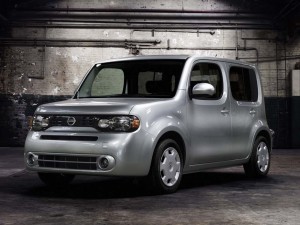
After a long wait while the Japanese automaker redesigned the boxy crossover for the American market, the 2009 Nissan Cube is finally rolling into local showrooms.
“For something with such rounded edges, how can they call it a Cube?” asked a good friend, recently. It’s one of those little questions I found myself pondering as I got the chance to drive Nissan’s new offering – and the latest entry into the expanding category of what might be called “box-mobiles.”
The 2009 Nissan Cube joins the list with the second-generation Scion xB and the current viral hit, Kia’s new Soul. The three of them start out as little more than boxes on wheels – when did square become hip? – about the most functional, flexible shape you can come up with. Then the makers round a corner here, exaggerate a beltline there, add a few hip, and sometimes goofy features, like Soul’s pulsing disco lights, and for the final touch, deliver the whole package at a surprisingly affordable price.
The 2009 Nissan Cube falls into the middle when it comes to cost, $14,710 for a base car, compared with $13,995 for the Soul and $16,420 for the xB. Our test car nudged the sticker price up another $8,000, money paid for such niceties as an upgraded audio system, lighted sill plates and one of the strangest accessories we’ve ever seen, a round piece of shag carpeting that looked a lot like a chia pet – or worse, some fungus – growing out of the top of the instrument panel.
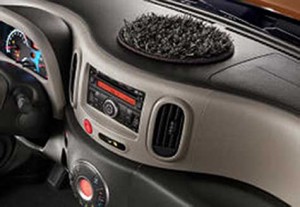
Is that a shag rug - or a chia pet - growing out of the instrument panel?
Okay, I’ll admit it, I’m likely well beyond the age of the typical box-mobile buyer, but I’ve yet to find anyone who could explain the appeal of that costly piece of misplaced carpeting. Folks did find a lot more fun with the mood lighting in the foot wells, the color of which one could change by rotating a knob on the center console.
Funkiness is a hallmark of the Cube. Park in front of a restaurant and virtually everyone in the front window will be talking and pointing. In a parking lot, folks will go out of their way to ask you about it. On the highway, other cars pull alongside to check you out. Not all the comments people make are favorable, but the crossover is certainly a conversation starter.
The original model, sold for years in Nissan’s Japanese home market, was notable for the asymmetric glass in the rear hatch, which notably swings open, like a refrigerator, rather than up, like the typical hatchback. Part of the problem was that the door -and much of the rest of the car — had to be re-engineered for the U.S., since Japanese drivers sit on the right side of the vehicle.
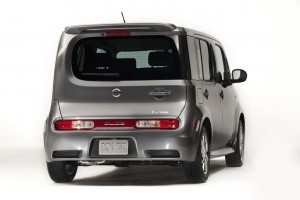
The rear of the 2009 Nissan Cube is where the crossover's unusual asymmetric design theme becomes most obvious.
Nissan was reluctant to go to all that expense until it was convinced there was a market. So, by the time the Cube arrived, the box segment was already getting crowded, making it subject to tougher scrutiny. The new Nissan is also being judged against itself, and more than a few long-time fans have criticized the new version. Like Scion’s xB, the latest generation of the Cube is larger, losing some of its original cuteness in the process. It’s also much more rounded, with odd bulges here and there, notably in the form of bulbous new bumpers. Of the three box-mobiles, Soul is now arguably most attractive, though Cube does grow on you, sort of like a chia pet.
Once you get past the distinctively quirky shape it’s time to consider what really matters: Cube’s large and pleasantly roomy interior. The vehicle’s tall design means that even a full-size male can sit comfortably in the back, though someone stuck in the middle seat might not want to drive very far. The front seats, meanwhile, are adequate, though they could use a bit more padding, especially if you’re planning a long drive.
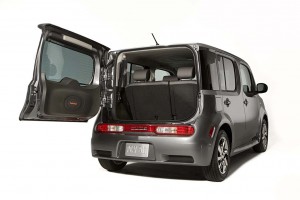
The rear of the 2009 Nissan Cube features a refrigerator-style door, rather than the traditional liftgate-type hatch.
The TV spots for Cube suggest there’s a huge cargo compartment. With both of the 60/40 split/fold back seats down, that’s absolutely true. With them up, you’re left with a relatively narrow but tall space, a problem if you’re going to try to stack a lot of grocery bags.
Nissan designers took pains to create a unified visual theme to the cabin, a sort of ripple wave effect most visible around the overhead light. The pattern repeats in various places, including the door-mounted speaker grilles and even the bottom of the cupholders.
The interior is reasonably well outfitted, at least for a car in this price segment. Materials are a bit on the basic side and we were surprised to find just one skinny center armrest on the driver’s seat, none for the passenger. Small details, like the backlit door sill covers are a nice, upscale touch, but they almost don’t go with the rest of the vehicle. Nor does the costly keyless ignition switch, a surprise on a car in this price class. One thing missing was a second 12-volt power plug, though you can get an iPod connector for the audio system that will charge that device while driving.
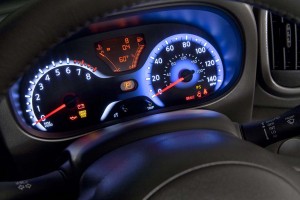
Nissan built in some interesting design elements with the 2009 Cube, including a handsome display package and some controllable accent lighting.
Don’t try to store anything, even keys, on the shag rug. It’s just for, um, aesthetic purposes, we’re told. There are lots of other places to store things, including the long center console, but it’s located near the floor, so you’re constantly stretching for cups or cellphones. The door-mounted armrests feature bungee cords for, what, storing parking tickets? (Certainly not speeding tickets, but more on that to come.)
While functionality is a key component of boxy designs, there are some trade-offs. The upright windshield generates a fair amount of wind noise – otherwise, Nissan’s done a good job of minimizing road noise – and it’s so far away that a taller driver will have to stretch and bend to see when the stoplight turns green. That’s particularly ironic since the massive side and rear windows provide great visibility in every other direction.
Like its competitors, the 2009 Nissan Cube is a sort of urban assault vehicle, designed for bopping around town rather than taking a long drive on the highway. Its 1.8-liter, inline-four engine makes an acceptable 122 horsepower. Yes, you can get a speeding ticket, but you’ll have to work at it. The engine is mated to Nissan’s well-designed and time-tested continuously variable transmission, about the only CVT we really like – and one of the few still left on the market. The Xtronic CVT minimizes that sense of “rubber-banding” experienced with other maker’s transmissions. Nissan does offer an alternative, a 6-speed manual, which we did not get to test.
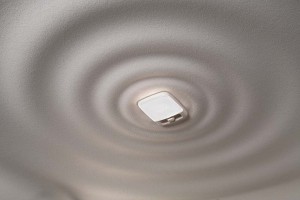
This wave pattern is the dominant interior theme of the 2009 Nissan Cube.
With the stick, Cube is rated at 24 mpg City, 29 highway. The CVT, however, boosts that to 28 and 30 and, unless you’re absolutely intent on doing your own shifts, it’s the better choice.
Unlike other cars in this price class, the 2009 Nissan Cube doesn’t seem all that small on the road. You won’t quickly feel boxed in on the highway. Road feel is reasonably good, though this is certainly no sports car. The short wheelbase is designed for maneuvering city streets.
For urban cruisers intent on making a statement – at an affordable price – the Nissan Cube is well worth considering. It definitely falls into the quirky category, but that’s what a lot of folks seem to be craving, these days, as the growing assortment of box-mobiles will demonstrate. Compared to the classic econobox — well, there really is no comparison – the 2009 Cube offers a lot for the dollar and is fun to drive. Nissan may have waited longer than necessary to bring it over. There will be a lot of American motorists ready to drive one home.
